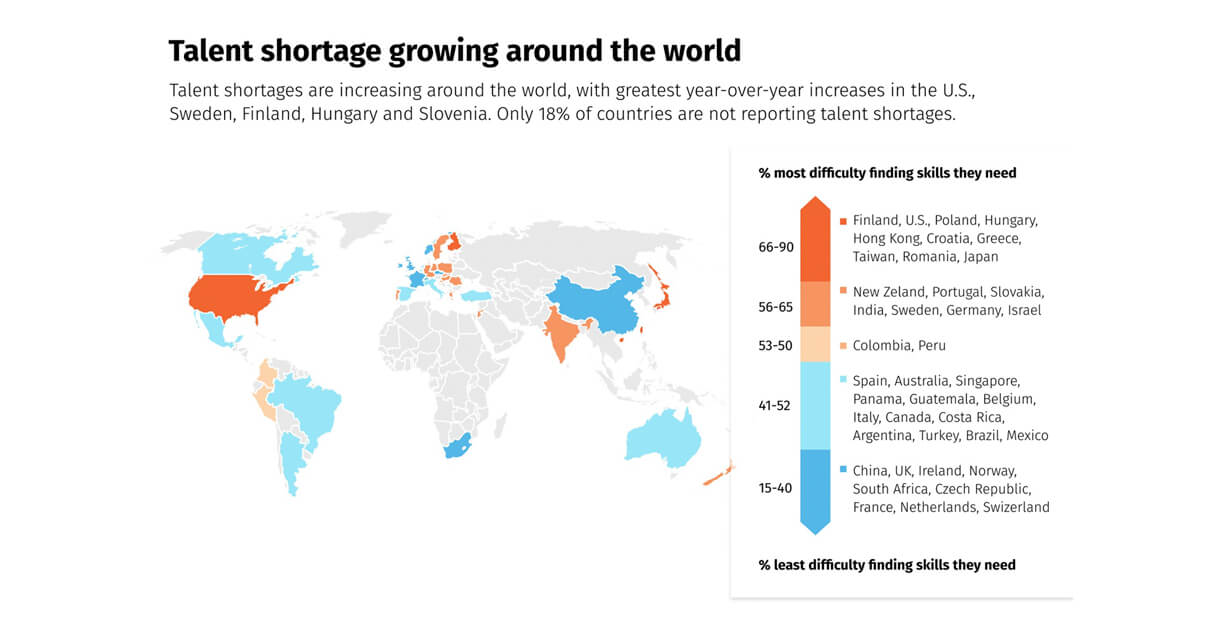In the ever-evolving landscape of technology, the demand for skilled IT professionals has reached unprecedented heights. As we enter 2023, the world faces a glaring and persistent issue: a shortage of IT professionals. This shortage is not confined to a single region or industry; it’s a global challenge impacting businesses, governments, and individuals.
Reasons for the Shortage
The IT talent shortage is not a new problem; however, its gravity has significantly intensified in recent years due to several key factors. This shortage, once a challenge confined to specific regions, has now escalated into a widespread crisis, affecting businesses, governments, and individuals alike.

1) Rapid Technological Advancements
The pace of technological change is relentless. Emerging technologies like artificial intelligence, blockchain, and quantum computing are reshaping industries. To stay competitive, organisations require skilled professionals who can harness these technologies effectively.
2) Digital Transformation and Increased Demand for IT Expertise
The COVID-19 pandemic accelerated the digital transformation of businesses worldwide. Remote work, e-commerce, and online services surged in demand, increasing the need for IT expertise in areas such as cybersecurity, cloud computing, and data analytics.
3) Aging Workforce and the Skill Gap
Many seasoned IT professionals are approaching retirement age, creating a gap in the workforce that is challenging to fill with younger, less experienced talent.
4) Educational Gaps and Industry Needs
Educational institutions struggle to keep pace with the rapidly changing tech landscape. The curriculum often lags behind industry needs, resulting in graduates lacking the skills employers require.
Consequences of the Shortage
The shortage of IT professionals reverberates far beyond the confines of individual organisations. It poses far-reaching consequences for various stakeholders, casting a shadow over innovation, productivity, and economic growth.

1) Business Disruption and Missed Opportunities
Companies face project delays, increased costs, and missed opportunities as they struggle to find qualified IT talent. This can lead to reduced innovation and competitiveness.
2) Cybersecurity Vulnerabilities and Increased Risks
With the growing reliance on digital technologies, the shortage of cybersecurity experts poses a significant risk. Cyberattacks are on the rise, and organisations must defend against increasingly sophisticated threats.
3) Innovation Stagnation and Its Impact on Global Growth
Research and development in emerging fields like AI, machine learning, and quantum computing may slow down due to a lack of experts, impacting global innovation and economic growth.
4) Economic Impact Across Industries
The IT talent shortage can hinder economic growth, as it affects industries ranging from healthcare to finance. This, in turn, affects job creation and overall prosperity.
Addressing the Shortage
To mitigate the global IT talent shortage, stakeholders must collaborate and take proactive measures. Education institutions need to evolve rapidly, aligning their curricula with the dynamic needs of the industry and ensuring graduates possess the necessary skills demanded by employers. On the other hand, employers must invest in continuous upskilling and reskilling initiatives for their existing workforce, bridging the skill gaps and reducing reliance on external hires.

1) Education and Training Alignment with Industry Needs
Educational institutions must align their programs with industry needs, offering relevant coursework and certifications. Lifelong learning initiatives can help IT professionals stay current.
2) Upskilling and Reskilling Initiatives for Existing Workforce
Employers should invest in the upskilling and reskilling of their existing workforce to bridge skill gaps and reduce dependency on external hires.
3) Promoting Diversity and Inclusion in Tech
Encourage diversity in the tech workforce to tap into a broader talent pool. This includes attracting and retaining underrepresented groups in IT roles.
4) Leveraging Remote Work Opportunities
Expanding remote work options can help organisations access talent from different regions and address geographical skill imbalances.
5) Government Support and Policies
Governments can incentivise IT education, promote apprenticeship programs, and support policies that encourage innovation and entrepreneurship.
The global IT talent shortage is a pressing issue in 2023, with far-reaching implications for economies and societies. It’s imperative for stakeholders to collaborate and invest in education, training, and workforce development to address this challenge effectively. Only by working together can we navigate this digital drought and secure a brighter future for the IT industry and beyond.


